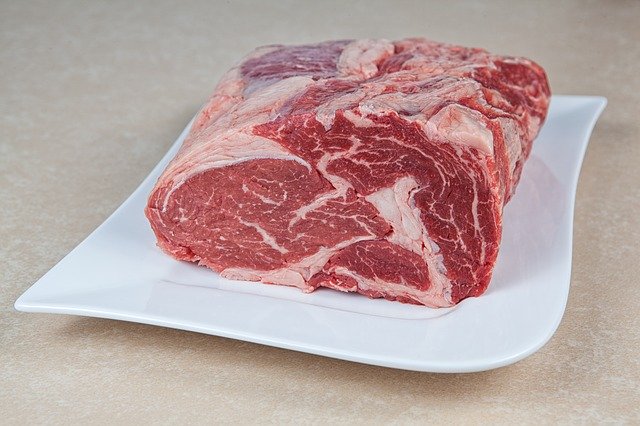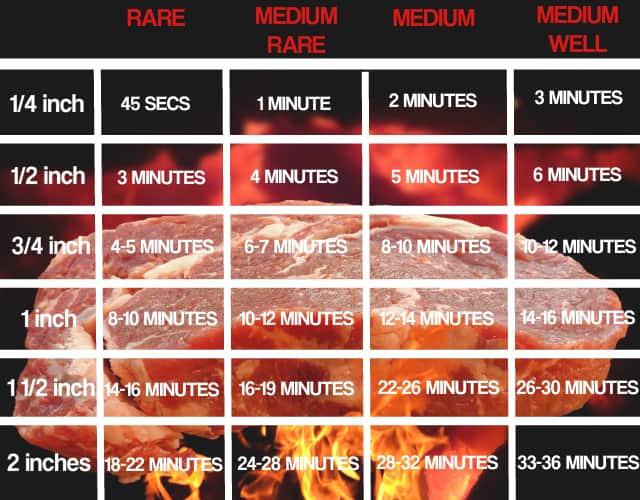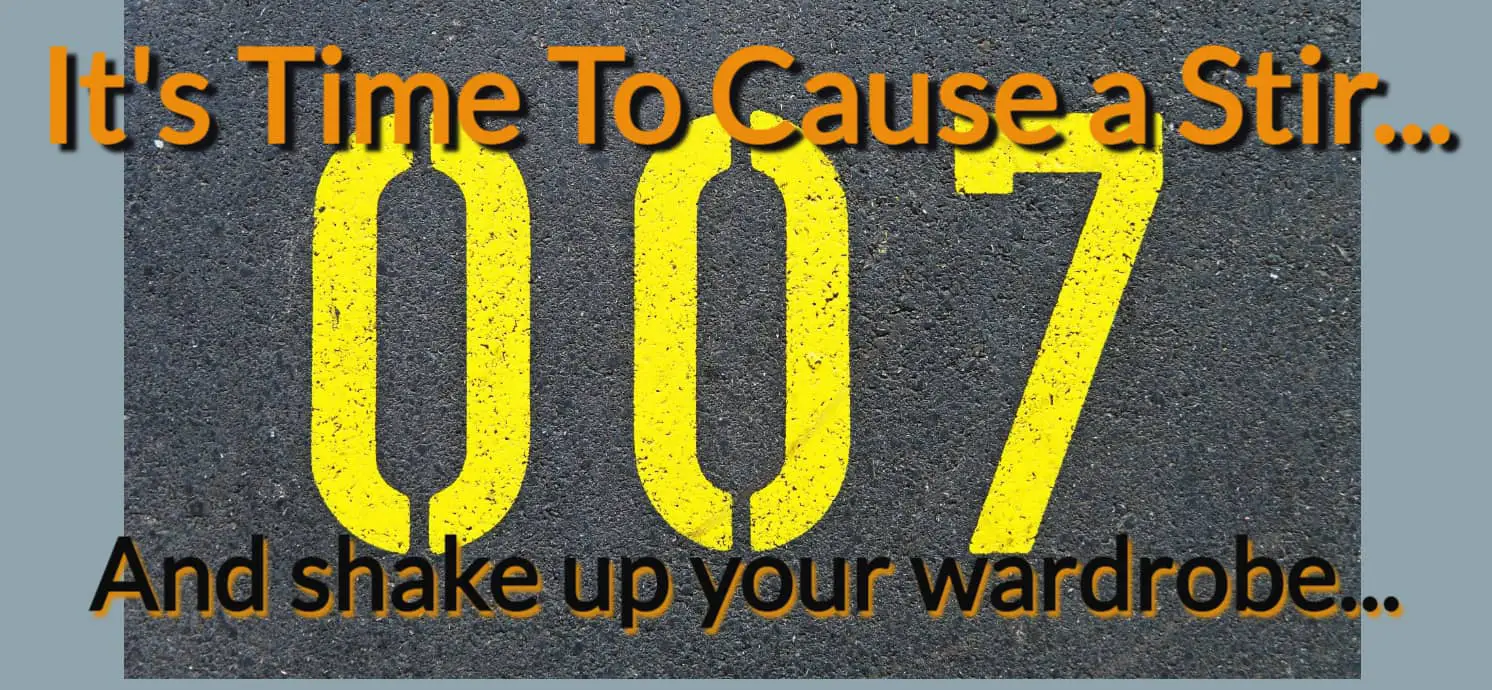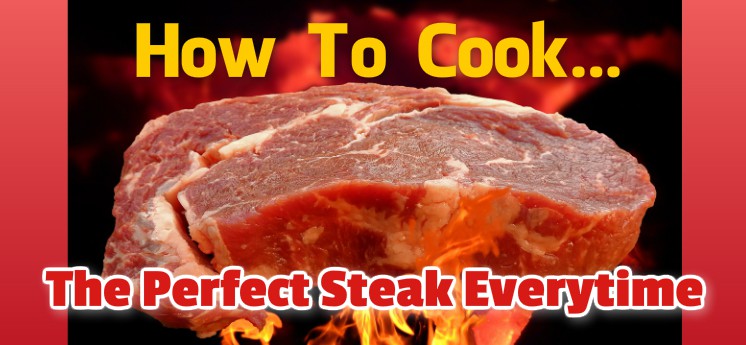Man+fire+meat+beer the four things every man needs to cook a steak like a pro. Well, almost…
You see the thing is, and once the beer is flowing, we men just “know” how to cook the perfect steak until a friend, your partner or your kids ask you to cook it in a way that differs from the way we like a steak cooked. And that’s when our beer-fueled alpha male attitude gets a kick in balls.
Do not despair though – if you keep just a few things in mind, you can find yourself on the road to beefy perfection and “know” for sure how to cook a steak, to any level of doneness whilst keeping your family jewels perfectly preserved.

Now, before we get into the actual cooking of steak, let’s start with a little background to set the scene.
A good steak starts in a barn. But, because you probably don’t plan on going into farming this week, for you it starts in the shop. This is important, if you have a decent independent local butcher, GO THERE. Not only are they going to have a better product at a better price, but they will probably be able to even tell you the name of the animal you are about to eat, and what its favorite TV show was. And you should nurture a friendship with a good local butcher because when it comes to steak and the best quality and cuts there’s no one more in the know.
My guy is this fat German stereotype looking chain smoker who calls everyone, male or female, “sweetcheeks”, and he doesn’t sell what he would not feed to his momma. And you don’t mess with his momma, she’s quarter his size and raises hell more than all 80’s heavy metal bands put together. A formidable woman who expects the best. Anyway, if I ask nicely, my butcher will set aside the same cut he gives his momma if I call ahead.
If you have to go corporate, still make friends with the people at the counter. They might not be able to always go above and beyond for you, but they can tell you what’s fresh on that day and the best cuts they have.

When it comes to the meat, you want to see more marble than in the Taj Mahal. Leaner stuff is not complete garbage, but the fat is where the flavor is. When it comes to consistency, think more french lace lingerie than your grandma’s doily. Finer streaks of fat will provide better texture, while thicker ones can turn into a greasy mess. Finer streaks also mean a higher price, but it will be worth it. In general, always seek the best possible quality you can afford because good ingredients take very little to come out amazing, even after a few beers.
To dry-age or not to dry-age? Well, most of the flesh at the counter has gone through some amount of dry-aging. Alton Brown has an easy method of giving your meat some extra love before cooking, or you could look into one of the home systems that have popped up in the past couple of years. Or you could go to a fancy-schmancy shop and get a 6-month-old chunk of smelly goodness – but only if you think that taking out a second mortgage is worth the ultimate, concentrated beefiness.
Or if you’re really organised and thinking ahead you could dry-age your beef yourself at home, and that’s seriously alpha man. And to be honest dry-aged beef has better texture and a better taste, so…
Golden tip – apart from the cooking, learning how to cook a steak as a pro starts with dry-aged beef.
Now, here’s the next golden tip – DON’T DO STUPID THINGS TO YOUR GOOD, EXPENSIVE STEAK. Leave the fusion-confusion for the cheaper cuts. With steaks – Keep. It. Simple. Salt, pepper, maybe some herbs. On the side, some ‘taters and salad, maybe go fancy with a ratatouille. Even if you are adding some surf to your turf, don’t needlessly complicate your life. We are all about adding some umami, but if you are no Magnus Nilsson, keep it simple. If you even think of a brine or marinade, slap some sense into yourself immediately..
The cooking method (the royal) we approve of, in order from least to the most skill needed, are sous-vide, pan/griddle, and grill.
Sous-vide might sound cheffy, but it’s the easiest way to achieve perfection even if you can’t boil water. Which, now that I think about it, might be a problem because sous-vide is cooking in water. In this video, Grant Crilly from Chefsteps (who, we presume, cooks even his toast sous-vide) shows you how easy and convenient this technique is. The downside? The start-up cost. Even if you go for the more affordable circulators and use plain ziplock bags instead of vacuum ones, it’s still an extra investment. It’s worth it for an active home cook, but if you enter your kitchen only during lunar eclipses, it’s just another gadget that will collect dust. Definitely worth a watch though…
A pan is probably the best choice for most. The best-case scenario, you already have a carbon steel or a cast iron pan in your cupboard. If not, write to Santa, steal one from your great-aunt, or simply go get one. They are cheap, reliable, and with a little bit of TLC, they will be your best friends for life. The main difference between the two that you have to be aware of is that carbon steel is lighter and heats up quickly, while cast iron heats up evenly and retains heat better. Which one is better for you depends on personal preference and what else you are going to use it for.
When it comes to the technique, Heston Blumenthal is the one who changed the game for everyone. His advice is to flip the steak every 15 to 20 seconds – this allows for a good crust to form while preventing the overcooking of the center. This method works for anything that walks and flies and, though a little labor-intensive, is as goof-proof as possible without going super high-tech.
Grilling should be left to someone who has both successfully cooked a steak before and successfully used their grill before. Presumably, you aim to fire up the grill to get both those marks and the hint of smokiness, right? Well, the smoke’s fine, but the marks will require you to keep the meat on the grill without moving it about too much. This time, experience is the best tool. The only insurance policy available is to cut your steak into super manly thick slices.
There are two easy ways to check for doneness – the Superman and the Clark Kent way.
This is how to cook a steak like a pro so when someone asks for their steak done medium, you’ll do it to perfection every time.
If you wanna go all Superman and stick your hand into the fire, go with the touch test. Learn it by feeling yourself up before you get your hand close to the heat, though. If you touch your thumb to your index finger, the feeling you would get from your thenar muscle (the muscle at the base of your thumb) is the same as raw meat. Your thumb and middle finger translate to rare, ring finger to medium, and pinky to well-done. Beyond that, it’s leather.
However, if you want more precision, do the Clark Kent and get thyself an instant-read thermometer. For rare you want to see 130 to 135, for medium-rare 140, for medium 155 and well-done 165 before you move your steak off the heat. Note that with sous-vide you set the ideal temperature and the steak will never go above it so, as long as you don’t leave it in the bath while you go on a Mediterranean cruise, it will come up perfect.
Now let’s talk about how to cook a steak link a pro with some steak cooking times – Have a look at this table:

Now, walk away. Leave it to rest – it had a hard day being sliced and cooked, give it some peace before it’s eaten. If you slice into it now, all of the juices will be gone. Take this time to build a pan sauce, if you used a pan at any point of course. You can wing this step a bit – deglaze the pan with some booze or stock to collect all that delicious fond (french for meat crust bits), add a bit of butter, a herb of choice and smashed garlic, and season to taste. It is that easy, and it will look freaking hot to your dining companion.
And the final step, take a second to pat yourself on the back you’ve just learned how to cook a steak like a pro.



































